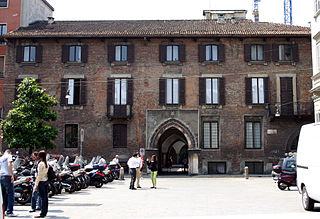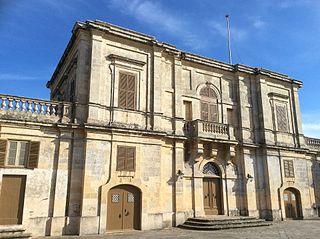
Casa Rocca Piccola is a 16th-century palace in Malta, and home of the noble Maltese family de Piro. It is situated in Valletta, the capital city of Malta. There are daily tours from 10am till 5pm. The palace includes a restaurant called La Giara Restaurant.

The Grandmaster's Palace, officially known as The Palace, is a palace in Valletta, Malta. It was built between the 16th and 18th centuries as the palace of the Grand Master of the Order of St. John, who ruled Malta from 1530 to 1798, and was also known as the Magisterial Palace. When the knights were expelled by Napoleonic France, it became the National Palace. During the period of British rule beginning in 1800, it was the Governor's Palace.

Palazzo Borromeo is a 14th-century building located at piazza Borromeo 12 in Milan, region of Lombardy, Italy. It was built as the home and business headquarters of the Borromeo family, merchant-bankers from Tuscany. Some of the building complex was badly damaged during World War II in Allied bombings of 1943 but was reconstructed and restored to its 15th-century appearance. It contains an important fresco cycle from the 1440s and is one of the finest examples of a Milanese patrician palace from the early Renaissance.

The Auberge d'Auvergne was an auberge in Valletta, Malta. It was built in the 16th century to house knights of the Order of Saint John from the langue of Auvergne. It became a courthouse in the 19th century, and it remained so until it was destroyed by aerial bombardment in 1941. The site is now occupied by the Courts of Justice building, which was constructed in the 1960s.

The Auberge de Bavière is a palace in Valletta, Malta. It was built as Palazzo Carneiro in 1696, and it was the residence of Grand Master Marc'Antonio Zondadari in the early 18th century. In 1784, it was converted into the auberge for the Anglo-Bavarian langue of the Order of Saint John, and it remained so until the French occupation of Malta in 1798.

Palazzo Correa, also known as Casa Correa, Correa de Sousa Palace or Palazzo Hompesch, was a 17th-century palace in Valletta, Malta, located in Old Bakery Street. It was built on the designs to architect Carlo Gimach in the Mannerist style, the first in Valletta and very unusual to the period.

Palazzo Parisio, sometimes known as Casa Parisio, is a palace in Valletta, Malta. It was built in the 1740s by Domenico Sceberras, and eventually passed into the hands of the Muscati and Parisio Muscati families. It was Napoleon's residence for six days in June 1798, during the early days of the French occupation of Malta. The palace was eventually acquired by the de Piro family, and was later purchased by the Government of Malta. It was used as the General Post Office from 1886 to 1973, then the Ministry for Agriculture, and it now houses the Ministry for Foreign Affairs.

The Banca Giuratale, formerly also known as Banca dei Giurati, the Municipal Palace, the Palazzo della Città, Casa Città and the Consolato del Mare, is a public building in Valletta, Malta. It was built in the 18th century to house the city's administrative council, and it was subsequently used as the General Post Office and the Public Registry. The Banca Giuratale now houses the Ministry for the Economy, Investment and Small Business, and it is officially known as Palazzo Zondadari.

Spinola Palace, also known as Spinola House, is a palace in Valletta, Malta. It belonged to the Spinola family between the 17th and 18th centuries. One third of the building was demolished in the 20th century, but the remaining two wings still exist and are now used as the head office of Lombard Bank.

Palazzo Dorell also known as Bettina Palace, is a 17th-century Palladian palace located in Gudja, Malta.

Palazzo Nasciaro is an 18th-century townhouse in Naxxar, Malta, built during the Order of St. John. The townhouse was originally built as a family home, but has undergone adaptive reuse several times to fit the changing needs of the local population.

Palazzo Palmerini is a 16th century civic building located in Alcamo, in the province of Trapani: the Palace is situated at Via Buonarroti.

The Hostel de Verdelin, also known as Palazzo Verdelin or the Casa delle Colombe, is a palace in Valletta, Malta. It was built in the mid-17th century for the knight Jean-Jacques de Verdelin, and it is an early example of Baroque architecture in Malta. The palace currently houses a police station and a restaurant.

Admiralty House, formerly known as Casa Miari, Palazzo Don Raimondo and by several other names, is a palace in Valletta, Malta. It was originally built in 1569–70 as two private houses by Fra Jean de Soubiran dit Arafat, a knight of the Order of St. John. The houses were later leased to various owners, including Fra Raimondo de Sousa y Silva, who rebuilt them a single residence between 1761 and 1763.

Republic Street, historically known as Strada Reale or Kingsway, is a principal street in the capital city of Valletta, Malta. It is about 1 kilometer long and is known for legislative, judiciary and commercial purposes. It is mostly pedestrianised.

The de Piro family is a Maltese noble family, of Italian origins, which settled in Malta with the Order of St John in 1530.

Alberto La Ferla (1898-1942) was a Maltese architect, active in the 1920s and 1930s.

Palazzo Sacchetti is a palazzo in Rome, important for historical and artistic reasons.





















